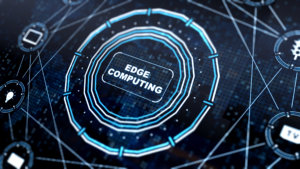EDGE Computing Vs. Computing At The Edge. Why It Really Matters!

Edge computing and computing at the Edge: identical words in a different order that deliver starkly opposite outcomes.
Computing at the edge replicates your data centers.
IBM, Dell, Nutanix, HP sell computing at the edge because it is an extension of what they sell – IT plumbing.
Since these are not software firms, they must rebrand whatever they have – hardware – in every emerging category. Putting little data centers in shopping malls or in a retail store is NOT edge computing. It is computing at the edge and it offers no commercial benefits above traditional compute.
Companies adopt this strategy in order to process closer to the customer and reduce network latency. While these ‘edge’ data centers may be physically smaller than centralized data centers, they rely on the same complex and expensive software infrastructure as large data centers.
Another critical limitation is the necessity of different code bases for each compute platform. One does not use the same code for an app running on an embedded device as one uses for the same app in the cloud or on a mainframe. Thus costs skyrocket and maintenance is a nightmare.
If one replicates data centers, costs replicate as well. These data centers at the network edge use VMware, Oracle, security products, and all of the other software infrastructure products associated with data centers – including all of their associated costs.
If one runs the same infrastructure as the main data center or cloud, everything else follows – apps are cumbersome, expensive, hard to build and increasingly difficult to maintain.
Apps continue to be I/O bound by the 7-9 layers of I/O that cause application thrashing and thus make apps run about a thousand to a million times slower than the silicon would allow.
Customers adopting this strategy of computing at the edge by replicating data centers at the edge of the network will not achieve sustainable differentiation from competitors. They have moved more IBM or Nutanix plumbing to the edge of the network. Anyone can do it.
Computing at the edge is NOT edge computing.
Fractal Programming – True Edge Tech Stack
Fractal Programming EDGE computing is a difference of kind, not of degree. True edge computing can best be attained using Fractal Programming, the next evolution of microservices.
Fractal Programming EDGE computing employs a fundamental distributed processing architecture, not just replicated data centers in remote locations.
There is NO NEED FOR A CENTRAL PROCESSOR OR CLOUD. Read that again: NO CLOUD OR DATA CENTER NEEDED. The distributed network is the data center.
Placing replicated data centers (plumbing) at the network edge enables a company to run perhaps hundreds of database processes simultaneously.
Fractal Programming EDGE computing, employing a deeply distributed architecture, runs tens of thousands to tens of millions of database processes simultaneously. Fractal Programming EDGE computing atomizes conventional software infrastructure into a granularity that makes edge computing a “difference of kind.”
Fractal Programming EDGE computing delivers its promise via a distributed architecture that can utilize a heterogeneous hardware mix of servers, embedded devices, and mobile devices such as tablets and phones. This is an inherent characteristic of Fractal Programming apps.
In Fractal Programming EDGE computing, the requirement for conventional, legacy data center software infrastructure disappears.
There is no need for Oracle or any other data center commercial DBMS. Ditto for VMware, conventional data center security products and middleware.
Fractal Programming EDGE computing delivers real-time processing, on virtually any hardware, at the network edge because it is built with an entirely different software technology stack. Fractal Programming EDGE delivers micro APPS that can run on any hardware, no code modifications needed.
Fractal Programming EDGE computing delivers the identical code base to every node – whether it is a server, a mainframe, the cloud, an embedded device or a mobile device.
Fractal Programming EDGE software stack is massively optimized to eliminate I/O wait states. The delay from hitting the enter key to parsing over 100 million records in a query is imperceptible.
The differences between computing at the edge and Fractal Programming EDGE computing are seen in the business outcomes.
If you are computing at the edge, nothing much changes except some network delays are reduced.
However, with Fractal Programming EDGE, everything changes:
- Applications run 1,000 to 1 million times faster
- Apps that used to run in large cloud data centers, now use bare Unix instances that reduce “value add” cloud costs to zero
- Storage is reduced 80-90 percent because of the elimination of RDBMS legacy constraints
- Applications that once took 2-3 years to build from scratch, now take a single business quarter
- IT costs are reduced 50 percent while applications are delivered in a fraction of the previous time
While these outcomes are impressive, the real power of Fractal Programming EDGE computing comes from what it enables, not what it eliminates.
Legacy batch systems, with 40-year-old patched (or even lost) source code, can now be rebuilt in weeks and made to run in real-time.
New digital applications can be imagined, built, tested, placed in production and in customer’s hands or on their phones in a single business quarter.
Two large corporations, each with intractable legacy systems, can deliver a real-time customer experience, via a partnership, to blend one’s products and the other’s distribution capabilities in real-time, in a single business quarter.
The outcomes are quite different.
Computing at the edge kicks the can down the road where nothing much changes. Fractal Programming EDGE delivers customer intimate apps, in real-time, at a fraction of legacy world costs.
Fractal Programming EDGE computing enables true digital transformation. Fractal Programming EDGE delivers micro APPS that are purpose built for true edge computing.
Learn more: www.Cloud-Sliver.com
Reprinted from Software Executive Magazine OnLine
